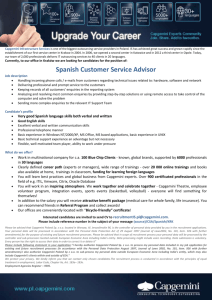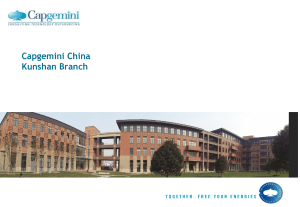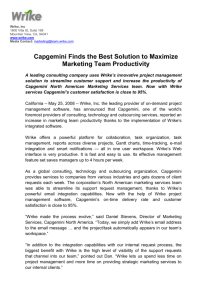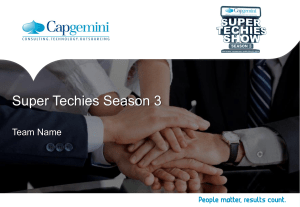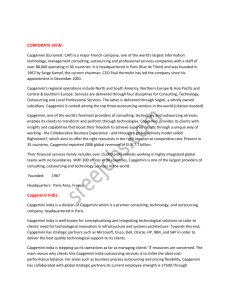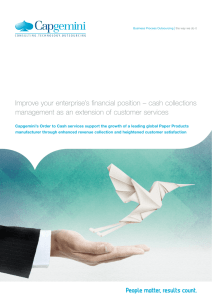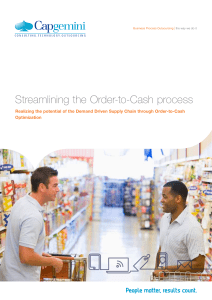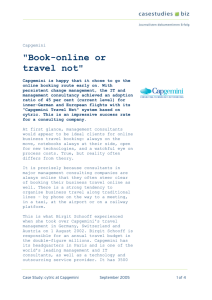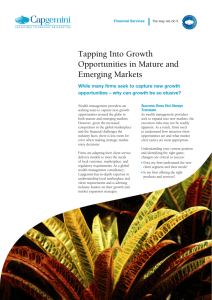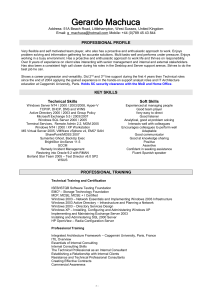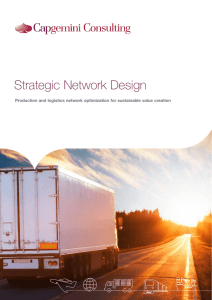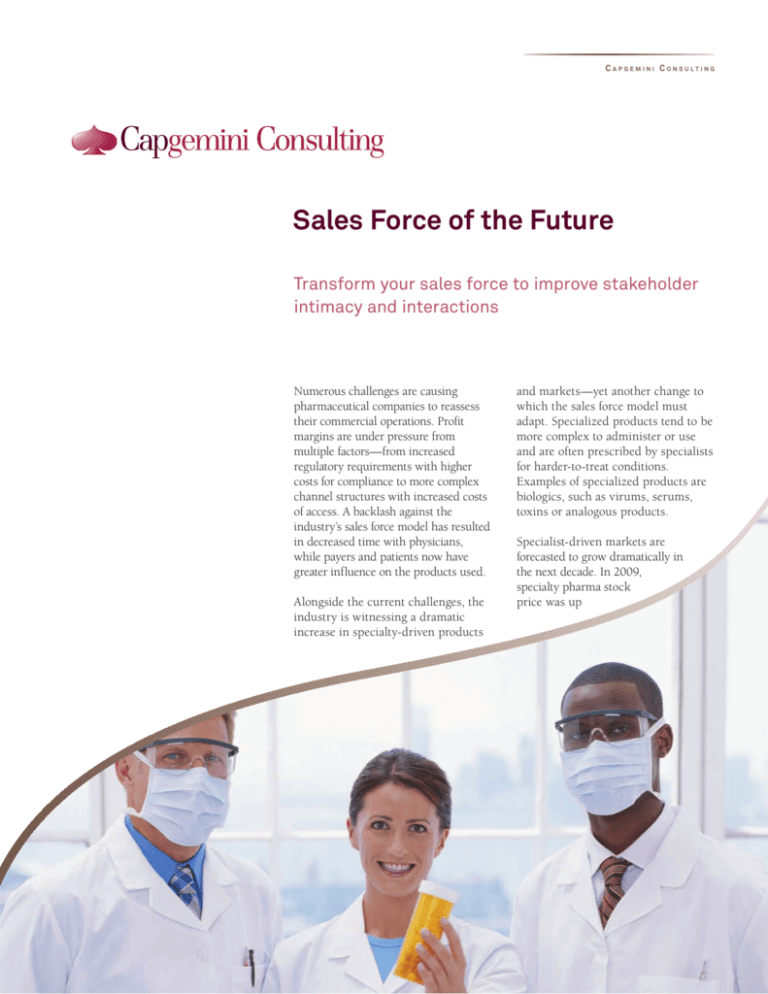
CAP GEMINI C ONSULTING
Sales Force of the Future
Transform your sales force to improve stakeholder
intimacy and interactions
In collaboration with
LOGO
PLACEHOLDER
(TABLE)
Numerous challenges are causing
and markets—yet another change to
pharmaceutical companies to reassess
which the sales force model must
their commercial operations. Profit
adapt. Specialized products tend to be
margins are under pressure from
more complex to administer or use
multiple factors—from increased
and are often prescribed by specialists
regulatory requirements with higher
for harder-to-treat conditions.
costs for compliance to more complex
Examples of specialized products are
channel structures with increased costs
biologics, such as virums, serums,
of access. A backlash against the
toxins or analogous products.
LOGO
LOGO
industry’s
sales force model has resulted
PLACEHOLDER
in PLACEHOLDER
decreased time with physicians,
Specialist-driven markets are
(TABLE)
while payers
and patients now have (TABLE)forecasted to grow dramatically in
greater influence on the products used.
Alongside the current challenges, the
industry is witnessing a dramatic
increase in specialty-driven products
the next decade. In 2009,
specialty pharma stock
price was up
The next wave in driving value from your existing shared
service investment
Figure 1: Key Stakeholder
Interactions
Customer
Face-toface
Remote
Field Rep
Non-field
Sales Structure
64.2 percent, outperforming a 23.5
percent increase in the S&P 500 index,
and signaling investors’ confidence in
the sub-sector’s future growth1. Today,
an estimated two-thirds of pharma
pipeline is concentrated on specialty
products2. As a result, smaller and
more specialized markets will require
sales forces to follow suit and become
more specialized and educational.
The traditional sales force model is not
equipped to meet developing industry
complexities. The traditional approach
is rigid and reach- and frequencydependent. A “one message fits all”
approach, on a national scale, is
pushed onto the customers. The sales
force has been almost the only method
of message delivery, while alternative
channels have been fragmented. As a
result, the sales force skill set has been
of a generic nature, focused on paper
details with little to no message
adjustment flexibility. Therefore,
shifting the sales force model is a key
lever in overcoming the industry’s
pressures and competitive challenges.
New Model for the
Sales Force of the Future
The definition of the customer is
widening from purely focused on
physicians to include a whole range
of stakeholders not previously
considered, such as KOLs, physician
assistants, nurses, office managers,
managed care officials, payers,
patients and advocacy groups. With
the expanding definition, improved
stakeholder intimacy underpins any
future design of the sales force model.
The Sales Force of the Future (SFF) is
designed around critical stakeholder
interactions and key elements of
2
customer-centricity, including a
deeper understanding of customer
needs, flexible regional structures and
broad skill sets, and an optimized mix
of channels and technology enablers.
In this future state model, each key
interaction has its own set of highimpact strategies (see Figure 1).
n Field Rep to Customer: Consultative
relationship, responsive nature (i.e.,
as-needed and on-demand)
n Non-field to Customer: E-detailing,
call centers, direct mail and
web interfaces
n Field Rep to Non-field: Regional
structure, localize intelligence,
account management focused
The SFF model is designed by selecting
the most appropriate combination of
the three approaches: Consultative,
Localization and Adaptive (see Figure
2). These three approaches are not
mutually exclusive and can be
deployed in various combinations.
Consultative Approach
A consultative approach is a structure
that fosters a trusted advisor
relationship between the sales rep and
the physician and/or practice. Under
this approach, the sales rep will have:
n An increased understanding of
customer and needs through
broader experience
n A single point of contact to the
customer, selling a portfolio
of products
n The ability to identify customer
issues and propose solutions
n Access to knowledge (e.g., specialists’
leading practices) with formalized
knowledge management structure,
processes and tools
Under the consultative approach, the
evolved sales force focuses on account
(or practice) selling and is comprised of
small, highly qualified medical
marketing teams. It actively manages
the profitability of the account by
owning a P&L as well as having a larger
portfolio under its belt.
Figure 2: Sales Force of the Future Model
Sales Force of the Future
Trusted advisor relationship
Localization Approach
A localization approach is a flexible,
regional structure that facilitates
more ownership down the chain
and provides for a more intimate
understanding of the customer. Such
a structure will foster:
n Go-to-market approaches tailored to
the local environment
n Decentralized decision-making
based on local trends (e.g.,
demographic, therapeutic)
n Greater regional responsibility and
support of multi-brand selling
Under this model, the sales force is
evolving from a headquarters-focused
to a regional-focused model,
increasing the local accountability of
the sales force on multiple fronts.
Regional sales forces are accountable
for a P&L, have a multi-brand strategy
to tailor to their specific area’s needs,
and have only one sales force per
territory. With this accountability, the
regions are also granted more
flexibility to choose the messaging
most relevant for their stakeholders.
Adaptive Approach
The adaptive approach focuses on the
in-house ability to analyze the
effectiveness of campaigns and
messaging and react swiftly and
proactively on a local and national
level. This approach will require:
Consultative
Deeper understanding of customer needs
Relationship building with all influencers
Value-add solutions (enhance physicians knowledge
and services)
Analyze and react
Resource optimization:
- Insource versus outsource
- Channel utilization
Synchronized message development and delivery
Message consistency
Data-driven insights
Adaptive
Flexible regional structure
Localization
Solutions targeted to local market conditions
Greater local accountability and decision-making
Removal of mirror sales forces
Multi-brand responsibility
Enablers
n
n
n
n
Technology (e.g., Tablet PCs, internet assets, CRM)
Dynamic, real-time marketing analytics
Bi-directional communication
Alternative detailing (e.g, web-detailing)
Superior, results-oriented analytics
capabilities that utilize real-time
data and advanced segmentations
that go beyond deciling (e.g.,
behavioral, attitudinal)
Flexible campaigns that integrate a
variety of channels and respond
quickly to analytic insights
Ability and willingness of the
sales rep to include different go-tomarket approaches
Leverage of the sales force as a highimpact, high-cost channel for highvalue targets or specific situations
(e.g., new product launch)
Sales Force of the Future
3
In implementing a Sales Force of
the Future model there are several
strategies that must be implemented
to meet the overall objectives.
n Maintain a balance between
increasing decision making,
accountability, and ownership
down the chain with a national
marketing approach
n Shift accountability and decision
making to regional sales managers
to promote stronger relationships
with customers
n Clearly define objectives and metrics
to help align regional managers with
increased responsibilities
n Effectively train, recruit and
communicate between regions
and headquarters
n Leverage change management to
uplift sales force morale in an
environment of deep cost cutting
As a global leader, Capgemini
Consulting works with you to unleash
your full potential and accelerate your
sales force transformation, providing
insights and capabilities that free you to
achieve tangible results.
Capgemini Consulting—Accelerating
Life Sciences’ Transformation. To learn
how Capgemini can help you develop a
Sales Force for the Future, contact us.
About Capgemini
Capgemini, one of the world’s
foremost providers of consulting,
technology and outsourcing services,
enables its clients to transform and
perform through technologies. Capgemini
provides its clients with insights and
capabilities that boost their freedom to
achieve superior results through a unique
way of working, the Collaborative Business
Experience™. The Group relies on its global
delivery model called Rightshore®, which
aims to get the right balance of the best
talent from multiple locations, working as
one team to create and deliver the optimum
solution for clients. Present in more than
30 countries, Capgemini reported 2009
global revenues of EUR 8.4 billion
(approximately USD $11.6 billion) and
employs 90,000 people worldwide.
Doug Moore
Capgemini Consulting
douglas.moore@capgemini.com
+1-312-395-5504
Capgemini Consulting is the Global
Strategy and Transformation Consulting
brand of the Capgemini Group, specializing
in advising and supporting organizations
in transforming their business, from
the development of innovative strategy
through to execution, with a consistent
focus on sustainable results. Capgemini
Consulting proposes to leading companies
and governments a fresh approach which
uses innovative methods, technology
and the talents of over 4,000 consultants
worldwide.
For more information:
www.us.capgemini.com/consulting
Vandana Bahri
Capgemini Consulting
vandana.bahri@capgemini.com
+ 1-908-239-1436
Capgemini Consulting contributing authors: Vandana Bahri, Ari Strasberg and Doug Moore.
1
Buck, David. “Health Care: Potent Pipelines.” Compiled Janet Levaux. Research Magazine. 1 Mar. 2010. Accessed 17 April 2010.
http://www.researchmag.com/Issues/2010/March-1-2010/Pages/Health-Care-Potent-Pipelines.aspx.
2
Looney, William. “The Case for Specialty Medicines: Is Industry Credible, or Culpable?” Pharma Exec Blog. Pharmexec.com, 11 Nov. 2009. Retrieved 17
April 2010. http://blog.pharmexec.com/2009/11/11/the-case-for-specialty-medicines-is-industry-credible-or-culpable/.
© 2010 Capgemini. All rights reserved. Rightshore® is a trademark belonging to Capgemini
010_CC_SFFPOV_030310
All three approaches are supported by
a set of enablers that are inherent
within the model:
n Advanced and dynamic technology
(e.g., CRM systems, field tools,
enhanced sales presentations)
n Bi-directional communication
n Integrated message development
and delivery
n Dynamic, real-time marketing
analytics and customer
segmentation strategies
n Alternative detailing, such as webdetailing, social networking
n Knowledge management

